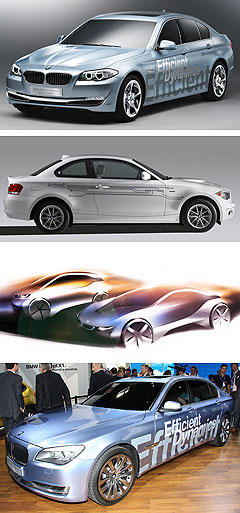Future models - BMW - 5 Series - Plug-in hybridShanghai show: BMW plugs in 5 Series for ChinaStretch hybrid: The Chinese-market long-wheelbase BMW 5 Series plug-in hybrid prototype. BMW-Brilliance joint-venture bears fruit with Chinese LWB 5 Series plug-in hybrid8 Apr 2011 IN STARK contrast to the unveiling of BMW’s hairy-chested M5 super-sedan at this month’s Shanghai motor show, Bavaria’s premium automaker will also use the event to debut a plug-in hybrid prototype of its Chinese-market long-wheelbase 5 Series. Slated for Chinese series production in 2013, the frugal 5 Series was developed in conjunction with Brilliance, the Chinese vehicle manufacturer with which BMW entered a joint-venture in 2003 so that it could penetrate the world’s fastest growing car market. Drive comes from a 160kW TwinPower petrol engine – probably related to the BMW’s new high-performance four-cylinder that is replacing the X1 crossover’s naturally-aspirated six-pot in some markets – supplemented by a 70kW electric motor. High-voltage batteries that can be charged using mains power are stored in the boot and hold enough charge to propel the BMW for up to a claimed 75km at a constant 60km/h. Once the batteries are exhausted, the petrol engine can add a further 400km to the range. Unlike General Motors’ Volt, which always uses electricity to power the wheels and a small range-extending petrol engine to generate voltage once the batteries run out, the BMW has a ‘parallel’ hybrid system in which petrol and electric power can power the wheels separately (for zero-emission driving) or in combination (for higher performance and to charge the batteries).  From top: BMW 5 Series hybrid, 1 Series ActiveE, BMW 'i', 2008 BMW 7 Series hybrid. From top: BMW 5 Series hybrid, 1 Series ActiveE, BMW 'i', 2008 BMW 7 Series hybrid.As GoAuto has reported, BMW premiered a hybrid 5 Series at the 2010 Geneva show in standard-wheelbase form, powered by a 40kW electric motor sandwiched between a twin-turbo straight-six petrol engine and the transmission. BMW claims that this combination reduces fuel consumption and emissions by 10 per cent while boosting available power for “an even more sporting driving experience”. The 5 Series hybrid – which is tipped for right-hand drive production and subsequently eligible for Australian delivery – followed production petrol-electric BMWs in the shape of North American-oriented, V8-based X6 and 7 Series hybrids, which are produced in left-hand drive only. While confirming the plug-in hybrid 5 Series is designed specifically for the Chinese market, BMW Group Australia head of corporate communications Piers Scot told GoAuto that it expects the technology to be applied further down the range. “We expect a right-hand drive hybrid to be produced. If this were the case, we would look at this model very closely for introduction in the Australian market,” he said. Despite more than half of Australia-bound BMWs now being powered by fuel-sipping diesels, Mr Scott said that the company does see strong potential for hybrids and EVs in Australia. “We will be monitoring the take-up rate in other similar markets,” he said. “These will complement, rather than replace, our diesel offerings as we see room for an array of mobility solutions in the short to mid-term.” The Shanghai show car is just part of a wider project by BMW to help get electrically powered vehicles into the Chinese marketplace. BMW’s first Chinese research project was the development of a purely electric 5 Series in conjunction with Tongji University in Shanghai. In addition, at the beginning of this year, China was added to the list of countries trialling the all-electric Mini E. China will also serve as a test bed for the 1 Series Coupe-based ActiveE, which made its first public appearance at Geneva last month and is motivated by a 125kW/250Nm, rear-mounted electric motor that draws power from lithium-ion batteries stored where the engine and fuel tank usually reside. Meanwhile, BMW is pressing ahead with its ‘i’ branded electric and hybrid vehicle range that will pioneer the use of aluminium underpinnings containing the battery, electric drive and impact-absorbing structures, capped by a lightweight, carbon composite passenger compartment. First cabs of the rank will be the city-sized i3 hatch – BMW’s first series-produced electric vehicle – and the i8 sports coupe that will share the i3’s electric motors, power electronics and lithium-ion batteries, supplemented by an internal-combustion engine.  Read more5th of April 2011  First look: BMW’s new M5 breaks outAll-new BMW M5 revealed as a thinly veiled concept ahead of Shanghai debut22nd of February 2011  BMW goes electric with iAll-electric city car and plug-in hybrid super coupe set to launch BMW i sub-brand11th of February 2011  Geneva show: BMW showcases infotainment, eco-techNew BMW design language, interactive and eco-friendly tech to be previewed at Geneva24th of January 2011  New hi-po four sounds death knell for BMW’s atmo sixTurbo all the way for BMW as X1 gets 180kW and 350Nm from 2-litre four-pot8th of November 2010  BMW confirms eco-supercarFirst hybrid supercar from BMW to join electric city car in showrooms from 20139th of August 2010  5 Series to be BMW’s first Oz hybridAustralia in line for next instalment of new 5 Series rollout as M5 and hybrid near5 Series pricing
Motor industry news |
Click to shareBMW models5 Series pricing
Motor industry news |
















Facebook Twitter Instagram